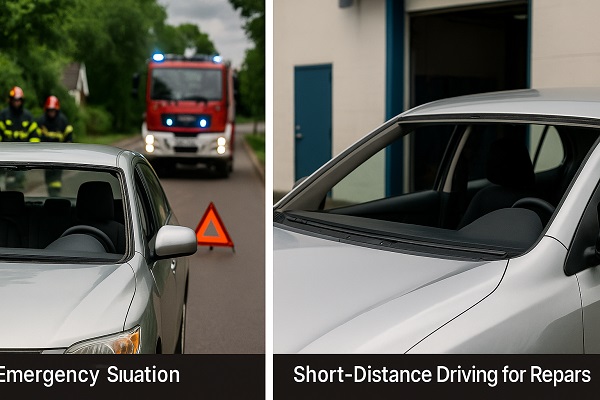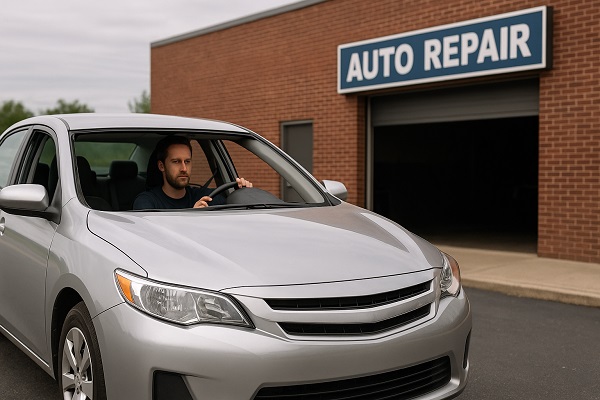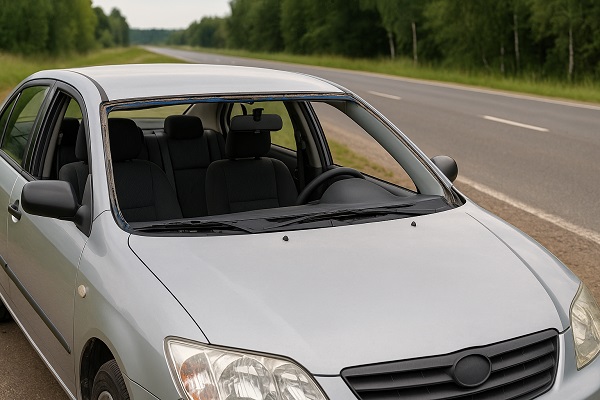Driving without a windshield, even for a short time, may seem like a harmless workaround in some situations—but it comes with significant risks and legal implications. Whether your windshield is cracked, missing entirely, or being replaced, it’s essential to understand what the law says and how it affects your safety on the road.
This guide explores whether it’s legal or safe to drive without a windshield temporarily, what exceptions exist, and what you should do if you find yourself in this situation.
Why Windshields Are So Important
The windshield is more than just a sheet of glass—it’s a critical component of your vehicle’s safety system.
Safety Functions of a Windshield:
- Protects occupants from road debris and weather
- Prevents ejection during collisions
- Supports proper airbag deployment
- Adds structural integrity to the roof
Even a short drive without a windshield puts you and your passengers at considerable risk.
Is It Legal to Drive Without a Windshield?
State Laws and Variations
Most U.S. states have laws that prohibit driving without a windshield. While the exact regulations vary, almost all states require:
- A windshield if the vehicle was originally manufactured with one
- Windshield wipers in working condition
- Unobstructed driver visibility
Some older or custom vehicles (like dune buggies or off-roaders) may be exempt from these requirements, but those are rare exceptions.
Legal Gray Areas
In a few states, driving without a windshield may technically be legal if:
- The vehicle is equipped with adequate eye protection (e.g., goggles)
- It’s not used on public roads
- It’s transported for repair or as part of a parade or event
However, even in these cases, you could still be ticketed for:
- Unsafe vehicle operation
- Failure to maintain clear visibility
- Endangering yourself or others
Colorado Laws on Driving Without a Windshield
If you’re in Colorado, the law is clear: vehicles must have a windshield if they were manufactured with one. According to Colorado Revised Statutes (§ 42-4-201 and § 42-4-227), the following rules apply:
Windshield Requirements in Colorado:
- Windshields are mandatory on vehicles that originally came with them.
- Windshield wipers must be present and functional.
- Obstructed or impaired vision through the windshield—such as large cracks or missing glass—can result in a citation.
Eye Protection Clause
While motorcycles and certain off-road vehicles can be operated with goggles or face shields instead of a windshield, this does not apply to passenger vehicles. Using sunglasses or safety goggles won’t make your car legal for street use without a windshield.
Can You Drive to a Repair Shop Without a Windshield?
Colorado law doesn’t explicitly allow or forbid driving a car without a windshield to a repair shop. However:
- You could still be cited for unsafe vehicle operation or obstructed view.
- It’s safer and smarter to use a tow service or have mobile repair technicians come to you.
- If stopped, you may need to show proof of appointment or repair intent, but that’s not a guarantee of leniency.
Driving without a windshield in Colorado is not advisable—even temporarily—unless you’re operating a vehicle that was legally exempt or designed without one. Always prioritize safety and compliance.
Situations Where You Might Consider Driving Without a Windshield

Though not recommended, some drivers consider removing or driving without a windshield due to:
- Sudden breakage or shattering
- Waiting for a replacement or repair appointment
- Off-roading or participating in car shows
Even in these scenarios, towing or using a temporary covering is almost always safer and more compliant with the law.
Risks of Driving Without a Windshield
Physical Risks
- Debris impact: Rocks, insects, and trash can strike you at high speeds
- Weather exposure: Rain, wind, and cold can impair driving ability
- Injury during collisions: No barrier to protect occupants
Mechanical and Performance Issues
- Aerodynamic drag reduces fuel efficiency
- Interior damage from wind and moisture
- Disruption of airbag systems designed to work with the windshield
Legal and Financial Consequences
- Traffic citations or fines
- Vehicle impoundment in extreme cases
- Voiding your insurance in an accident
What to Do if Your Windshield Is Damaged or Missing
If you’re dealing with a cracked or missing windshield, take these steps instead of driving:
Safer Alternatives
- Call a mobile auto glass repair service
- Use a tow truck or flatbed to move the vehicle
- Park in a safe location until repairs can be made
Avoid Makeshift Solutions
Don’t attempt to replace the windshield with plastic wrap, cardboard, or plexiglass. These won’t meet safety standards and could result in additional citations or danger.
Can You Use Eye Protection Instead?
In some places, eye protection like safety goggles or a face shield might satisfy legal requirements—but only under specific conditions.
When Eye Protection Might Be Acceptable
- If you’re driving a vehicle designed without a windshield (like a motorcycle or ATV)
- If you’re on private property
- If local laws specifically allow it (check with your DMV)
For standard cars or trucks, eye protection alone is not enough to ensure safety or legal compliance.
Exceptions for Specialty and Off-Road Vehicles
Certain vehicles are built to be driven without a windshield. These include:
- Dune buggies
- Jeeps with removable windshields
- Off-road UTVs
- Military or parade vehicles
Even then, usage is typically limited to off-road environments or private land. Once on public streets, standard laws apply.
What About Temporary Covers?
Some people wonder if they can cover the windshield opening temporarily while driving.
Common Cover Types and Issues
- Plastic sheeting: Flaps in the wind and obscures vision
- Clear vinyl: Deforms in heat and rain
- Plexiglass: May not meet DOT safety standards
None of these materials are legal replacements for automotive safety glass. Additionally, your vision will be compromised—which can result in citations or accidents.
Can You Drive Without a Windshield to the Repair Shop?

This is a common question, and the answer depends on where you live.
General Guidelines
- Call your local police department or DMV for guidance
- Use a tow service if you’re unsure
- Document your intent to repair in case you are pulled over
Some law enforcement officers may be lenient if you’re clearly en route to a repair shop, but this is not guaranteed. You could still face fines or be ordered off the road.
Insurance and Liability Considerations
Driving without a windshield could void certain aspects of your insurance policy, especially if:
- You’re involved in an accident
- You ignored previous warnings about visibility or safety
- You drove after the damage occurred
Always check with your insurance provider. Many offer mobile windshield replacement services to help you stay covered without driving the vehicle.
Tips for Preventing Windshield Emergencies
- Repair chips early before they spread
- Avoid slamming doors when windows are up, as pressure can crack the glass
- Use proper de-icing methods in winter to prevent stress fractures
- Park in shaded areas to reduce heat stress on glass
Prevention is far easier—and cheaper—than dealing with a total windshield failure.
Driving without a windshield temporarily is almost never a good idea. Whether you’re considering a short drive to a repair shop or trying to finish a trip after sudden damage, the risks outweigh the convenience. Legally, you’re putting yourself in a vulnerable position. From a safety standpoint, you’re removing one of your vehicle’s most important protective components.
If your windshield is damaged or missing, arrange for professional repairs or towing. Don’t take the chance with your safety, your passengers, or other drivers on the road.
Content reviewed and published by SLP AutoGlass Editorial Team.

